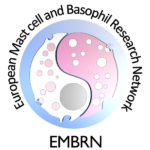In mammals, the successful implantation of the blastocyst into the endometrium and the subsequent development of a decidual cell response involve many interactions between the mother and the conceptus [1]. Uterine-derived histamine has long been suspected as a key regulator in implantation due to its ability of altering uterine vascular permeability and inducing stromal decidualization [2]. Histamine is produced mainly by MCs that are present in both the uterus and placenta [3]. Moreover, human preimplantated embryos induce MCs to release histamine by secreting histamine releasing factor [4]. The invasion of trophoblast cells into the maternal endometrial tissue is not the result of passive growth pressure but of an active biochemical process [5–7]. It necessarily involves the destruction and/or displacement of the basement membrane, extracellular matrix (ECM) and possibly cellular components of the maternal decidua. This process is regulated by a fine balance between the production of proteolytic pro-enzymes (in particular matrix metalloproteinases, MMPs), their physiological activators (e.g. plasmin) and their inhibitors (tissue inhibitors of metalloproteinases, TIMPs). The proteolytic enzymes, capable of digesting the different constituents (several collagen types, laminin, fibronectin) of the endometrial basement membrane/ECM, are considered the rate-limiting steps of the trophoblastic invasion [8–10]. The potential role of the MCs on mediating ECM degradation trough the activation and production of metalloproteinases MMPs has been highlighted [11]. Moreover, MC tryptases and chymases have been shown to activate the precursors of MMP2 [12], MMP9 [13], collagenase and stromelysin [14].
The presence of MCs in the uterus has been already described in many species including human [15], mouse [16], rat [17], hamster [18] as well as goat [19]. Besides, the number of MCs in the uterus was shown to fluctuate during estrous cycle suggesting an influence of female sex hormones on MC recruitment to the uterus [17]. Thereby, these hormones might act directly as MCs express estradiol and progesterone receptors (ER and PR) [20-26]. Zaitsu et al. demonstrated that estradiol rapidly stimulated MC degranulation which could be blocked by tamoxifen, a tissue specific ER antagonist, clearly indicating that estradiol-induced MC degranulation throughout one of its receptors. Bone marrow-derived MCs (BMMCs) isolated from ERα knockout animals did not degranulate in response to E2 treatment confirming that the E2 effect on MCs is more likely mediated by the ERα [25]. Ovariectomized mice, in which estradiol and progesterone are almost absent, have less number of uterine MCs compared to control, non-ovariectomized animals [20]. Hormonal replacement, estradiol alone or in combination with progesterone, restored the number of uterine MCs after ovariectomization, which was comparable to the levels observed in control mice [20]. Hormonal replacement additionally induced an augmentation in the levels of MC-related proteases expression in the uterus as well as boosted MC degranulation [20].
References:
| 1. | Wordinger RJ, Orr EL, Pace K, Oakford L, Morrill A (1985) An assessment of mast-cell deficient mice (W/Wv) as a model system to study the role of histamine in implantation and deciduoma formation. J Reprod Fertil 73:451–6. |
| 2. | Johnson DC, Dey SK (1980) Role of histamine in implantation: dexamethasone inhibits estradiol-induced implantation in the rat. Biol Reprod 2:1136–41. |
| 3. | Liu Z, Kilburn BA, Leach RE, Romero R, Paria BC, Armant DR (2004) Histamine enhances cytotrophoblast invasion by inducing intracellular calcium transients through the histamine type-1 receptor. Mol Reprod Dev 68:345–53. |
| 4. | Cocchiara R, Di Trapani G, Azzolina A, Albeggiani G, Geraci D (1986) Early embryonic histamine-releasing factor: a new model for human implantation. Hum Reprod 1:445–7. |
| 5. | Fisher SJ, Leitch MS, Kantor MS, Basbaum CB, Kramer RH (1985) Degradation of extracellular matrix by the trophoblastic cells of first-trimester human placentas. J Cell Biochem 27:31–41. |
| 6. | Fisher SJ, Cui TY, Zhang L, Hartman L, Grahl K, Zhang GY, Tarpey J, Damsky CH (1989) Adhesive and degradative properties of human placental cytotrophoblast cells in vitro. J Cell Biol 2:891–902. |
| 7. | Shimonovitz S, Hurwitz A, Dushnik M, Anteby E, Geva-Eldar T, Yagel S (1994) Developmental regulation of the expression of 72 and 92 kd type IV collagenases in human trophoblasts: a possible mechanism for control of trophoblast invasion. Am J Obstet Gynecol 171:832–8. |
| 8. | Bischof P, Martelli M, Campana A, Itoh Y, Ogata Y, Nagase H. (1995) Importance of matrix metalloproteinases in human trophoblast invasion. Early Pregnancy 1:263–9. |
| 9. | Bischof P, Friedli E, Martelli M, Campana A (1991) Expression of extracellular matrix-degrading metalloproteinases by cultured human cytotrophoblast cells: effects of cell adhesion and immunopurification. Am J Obstet Gynecol 165:1791–801. |
| 10. | Cohen M, Meisser A, Bischof P (2006) Metalloproteinases and human placental invasiveness. Placenta 27:783–93. |
| 11. | Baram D, Vaday GG, Salamon P, Drucker I, Hershkoviz R, Mekori YA (2001) Human mast cells release metalloproteinase-9 on contact with activated T cells: juxtacrine regulation by TNF-alpha. J Immunol 167:4008–16. |
| 12. | Lohi J, Harvima I, Keski-Oja J (1992) Pericellular substrates of human mast cell tryptase: 72,000 dalton gelatinase and fibronectin. J Cell Biochem 50:337–49. |
| 13. | Fang KC, Raymond WW, Lazarus SC, Caughey GH (1996) Dog mastocytoma cells secrete a 92-kD gelatinase activated extracellularly by mast cell chymase. J Clin Invest 97:1589–96. |
| 14. | Lees M, Taylor DJ, Woolley DE (1994) Mast cell proteinases activate precursor forms of collagenase and stromelysin, but not of gelatinases A and B. Eur J Biochem 223:171–7. |
| 15. | Drudy L, Sheppard B, Bonnar J (1991) Mast cells in the normal uterus and in dysfunctional uterine bleeding. Eur J Obstet Gynecol Reprod Biol 39:193–201. |
| 16. | Padilla L, Reinicke K, Montesino H, Villena F, Asencio H, Cruz M, Rudolph MI (1990) Histamine content and mast cells distribution in mouse uterus: the effect of sexual hormones, gestationand labor. Cell Mol Biol 36:93–100. |
| 17. | Aydin Y, Tunçel N, Gürer F, Tuncel M, Koşar M, Oflaz G (1998) Ovarian, uterine and brain mast cells in female rats: cyclic changes and contribution to tissue histamine. Comp Biochem Physiol 120:255-262. |
| 18. | Harvey EB (1964) Mast cell distribution in the uterus of cycling and pregnant hamsters. Anat Rec 148:507-516. |
| 19. | Karaca T, Arikan S, Kalender H, Yoruk M (2008) Distribution and heterogeneity of mast cells in female reproductive tract and ovary on different days of the oestrus cycle in Angora goats. Reprod Domest Anim 43:451–456. |
| 20. | Jensen F, Woudwyk M, Teles A, Woidacki K, Taran F, Costa S, Malfertheiner SF, Zenclussen AC (2010) Estradiol and progesterone regulate the migration of mast cells from the periphery to the uterus and induce their maturation and degranulation. PLoS One 5:e14409. |
| 21. | Theoharides TC, Dimitriadou V, Letourneau R, Rozniecki JJ, Vliagoftis H, Boucher W (1993) Synergistic action of estradiol and myelin basic protein on mast cell secretion and brain myelin changes resembling early stages of demyelination. Neuroscience 57:861–871. |
| 22. | Chancey AL, Gardner JD, Murray DB, Brower GL, Janicki JS (2005) Modulation of cardiac mast cell-mediated extracellular matrix degradation by estrogen. Am J Physiol Heart Circ Physiol 289:H316–H321. |
| 23. | Pang X, Cotreau-Bibbo MM, Sant GR, Theoharides TC (1995) Bladder mast cell expression of high affinity oestrogen receptors in patients with interstitial cystitis. Br J Urol 75:154–161. |
| 24. | Narita S, Goldblum RM, Watson CS, Brooks EG, Estes DM, Curran EM, Midoro-Horiuti T (2007) Environmental estrogens induce mast cell degranulation and enhance IgE-mediated release of allergic mediators. Environ Health Perspect 115:48–52. |
| 25. | Zaitsu M, Narita S, Lambert KC, Grady JJ, Estes DM, Curran EM, Brooks EG, Watson CS, Goldblum RM, Midoro-Horiuti T (2007) Estradiol activates mast cells via a non-genomic estrogen receptor-alpha and calcium influx. Mol Immunol 44:1977–1985. |
| 26. | Jing H, Wang Z, Chen Y (2011) Effect of oestradiol on mast cell number and histamine level in the mammary glands of rat. Anat Histol Embryol 41:170–176. |



